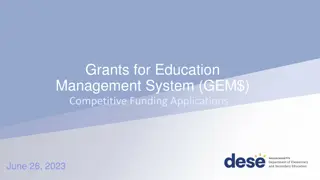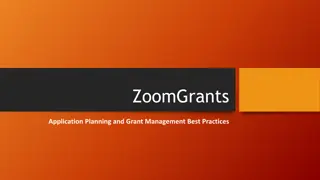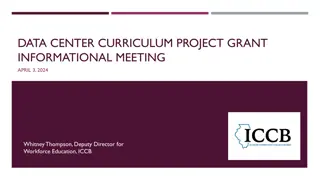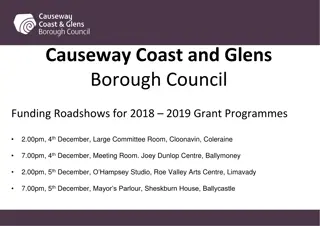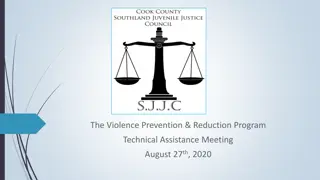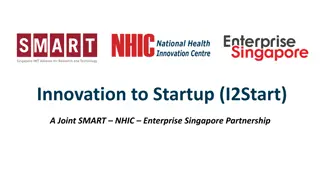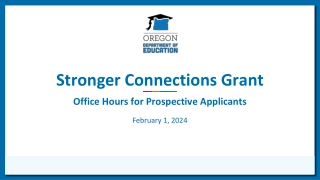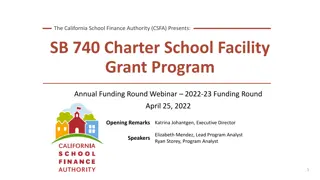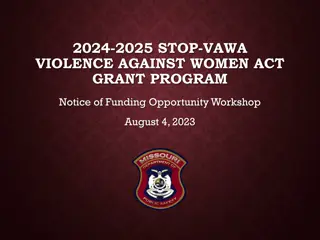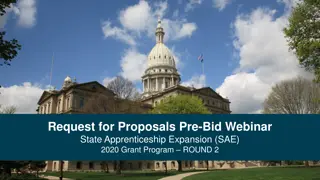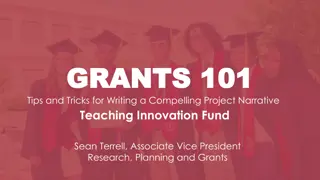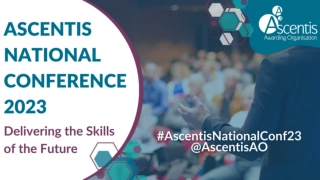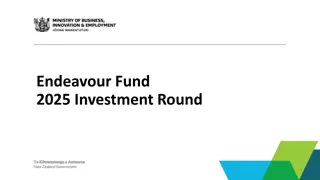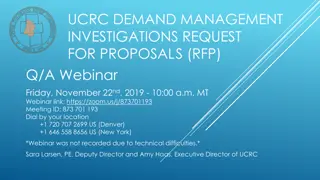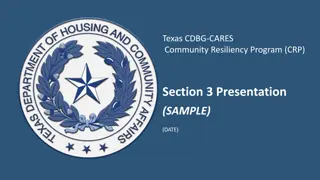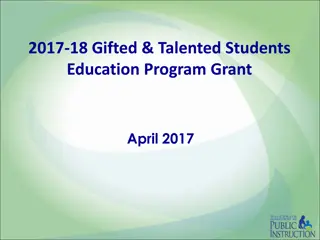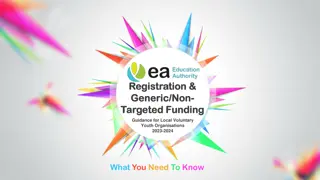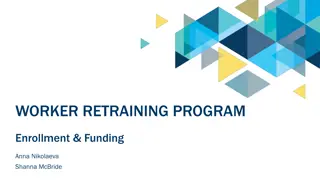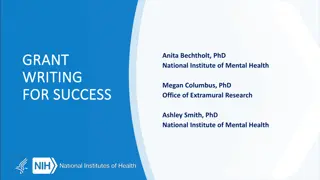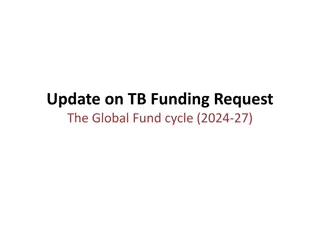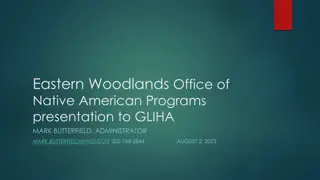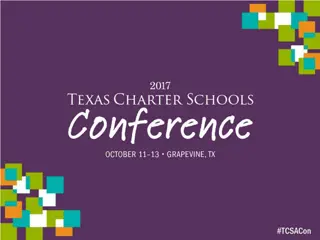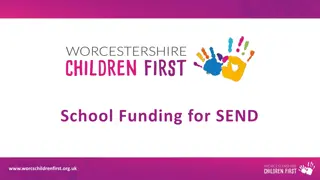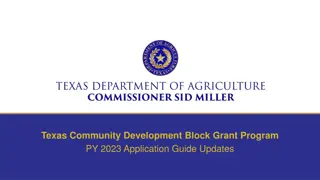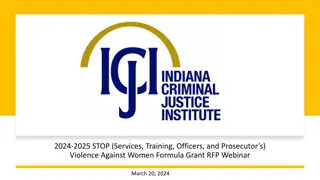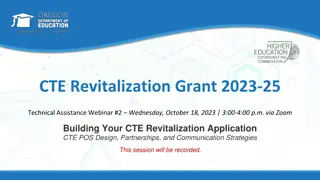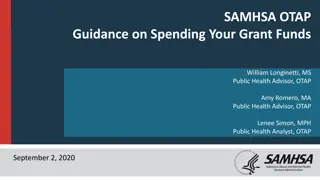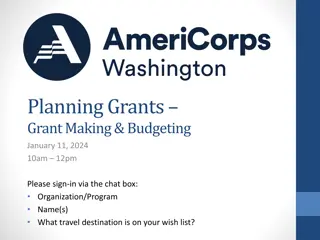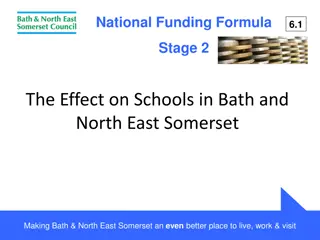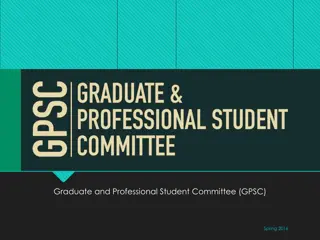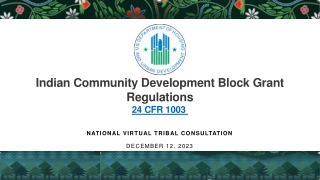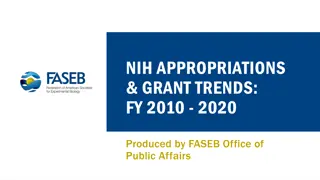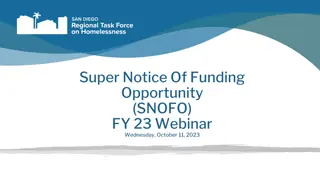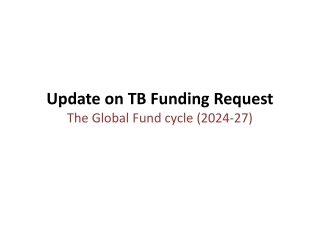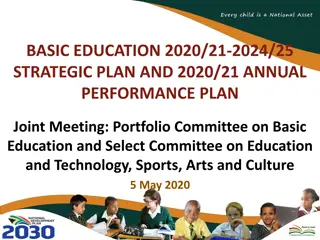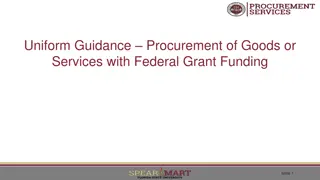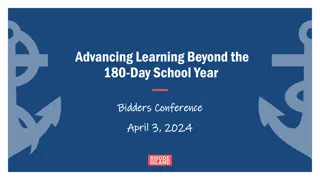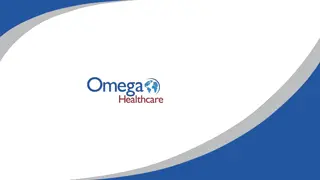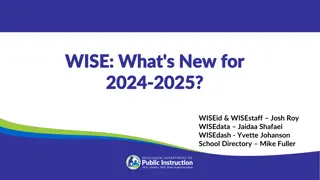Funding Opportunity: CSTEP Grant Program for 2020-2025
The Collegiate Science and Technology Entry Program (CSTEP) is offering grants for the fiscal years 2020-2021 through 2024-2025 to increase access for minority and disadvantaged students to academic programs in scientific and technical fields. The RFP outlines important dates, eligibility criteria, funding projections, and prequalification requirements for applicants. Institutions must apply by the deadline for a chance to receive funding for projects that align with CSTEP's mission.
Download Presentation

Please find below an Image/Link to download the presentation.
The content on the website is provided AS IS for your information and personal use only. It may not be sold, licensed, or shared on other websites without obtaining consent from the author. Download presentation by click this link. If you encounter any issues during the download, it is possible that the publisher has removed the file from their server.
E N D
Presentation Transcript
Request for Proposals (RFP) GC#20-004 Fiscal Years 2020-2021 through 2024-2025
Important Dates Questions regarding this RFP must be e-mailed by October 4, 2019 to CSTEPRFP@nysed.gov Questions and Answers Summary will be posted no later than October 18, 2019to the following website: http://www.nysed.gov/postsecondary-services/collegiate-science- and-technology-entry-program-cstep Applications Due: Postmarked by November 8, 2019 Anticipated Preliminary Notification of Awards: January 21, 2020 (Pending an approved state budget and approval from Division of Budget). CSTEP Period: Programs may begin as early as July 1, 2020 and must be completed by June 30, 2025.
Background & Purpose In 1986, the New York State Legislature passed an amendment to Education Law Chapter 31, Article 130, 6455, to authorize the use of funds under the Collegiate Science and Technology Entry Program (CSTEP). According to 6455 of the Education Law , CSTEP is: for the purpose of increasing access by minority or disadvantaged students to academic programs that have been registered by the commissioner and that prepare students either for licensure in the professions or for employment in scientific and technical fields.
Funding Projections During the 2019-20 program year, $11.9 million was awarded to 55 projects. Future awards depend on annual legislative appropriation, but it is anticipated that funding will continue at the same approximate levels. This RFP covers a five-year funding cycle from July 1, 2020, through June 30, 2025. There is a 25% match required for each year of funding from any combination of institutional and/or other non-NY state funds.
General Eligibility Accordingto 145-6.6(b) of the Commissioner sRegulations, eligible applicant means: a degree-granting postsecondary institution, or a consortium of such institutions, which offers an approved undergraduate program of study and/or an approved graduate level program of study. **The Research Foundation is NOT a degree granting institution. Programs must serve full-time, matriculated students who are working toward an approved degree. Therefore, for a proposal to be reviewed, the degree- granting institution or lead institution of a consortium of such institutions must be the applicant/fiscal agent. A third party or other entity may not serve as the applicant/fiscal agent.
Prequalification Requirement The prequalification process designed to facilitate prompt contracting for not-for-profit vendors. State of New York has implemented a statewide All not-for-profit vendors are required to pre-qualify by the grant application deadline in order to be eligible for this grant. This includes all currently funded not-for-profit institutions that may have previously received an award and are in the middle of the program cycle. https://grantsmanagement.ny.gov/resources-grant-applicants
Eligible Institutional Applicant According to 145-6.6(b) of the Commissioner s Regulations, eligible applicant means: a degree-granting postsecondary institution, or a consortium of such institutions, which offers an approved undergraduate program of study and/or an approved graduate level program of study. Each institution may submit more than one proposal only if the institution has two or more geographically separate campuses and serves their own distinct contracted and unduplicated headcount. An institution may not submit applications as both a consortium and stand- alone program unless the programs are located on and serve two geographically separate campuses. A consortium is defined as an association or grouping of institutions set up for a common purpose that would be beyond the capabilities of a single member of the group. A consortium must meet all requirements established in NYSED s Consortium Policy for State and Federal Discretionary Grant Programs found in Section VI of this RFP. Both non-profit and for-profit institutions are eligible to apply.
Eligible Participant (Student) To be eligible for undergraduate Collegiate Science and Technology Entry Program support, a student must be a resident of New York who is either economically disadvantaged OR from underrepresented in the scientific, technical, health and health-related professions, and who demonstrates interest in and a potential for a professional career if provided special services. Eligible students must be in good academic standing, enrolled full-time in an approved program of study, as defined by the Regents (http://www.nysed.gov/heds/IRPSL1.html). a minority group historically The student is a resident of the State if any of the following apply: The student now resides in New York State and will be an undergraduate and has lived in New York State for the last year of high school; or The student was a resident when the they entered military service, VISA, or the Peace Corps and re-established New York State residency within six months after release fromservice; or The student has resided in New York State for at least 12 months immediately preceding the first term for which the applicant is enrolled as an undergraduate or graduate student in CSTEP and has established domicile (permanent residence) in New York State.
HistoricallyUnder-represented 11 According to 145-6.6(b) of the Commissioner s Regulations, minorities historically underrepresented in the scientific, technical, health and health-related professions means residents of New York State or permanent resident aliens residing in New York State who are Black, Hispanic, American Indian or Alaskan Native.
Economically Disadvantaged For the purpose of CSTEP , a student who is economically disadvantaged means a student who meets the criteria set forth in section 27-1.1 of the Rules of the Board of Regents. The Income eligibility criteria will be published annually by NYSED for the 2020-2025 funding cycle. The eligibility standards set forth apply only at the time of admission as a first-time student to a CSTEP program. Once admitted, a student may continue to receive supportive services as needed, even if the family income rises above the current eligibility standards. Additional documentation of household income need not be collected if the student falls into one of the following categories, and documentation is available to demonstrate: the student's family is the recipient of family assistance program aid or safety net assistance through the New York State Office of Temporary and Disability Assistance or a county department of social services; or is the recipient of family day-care payments through the New York State Office of Children and Family Services or a county department of social services; the student is living with foster parents who do not provide support for college, and no monies are provided from the natural parents; or the student is a ward of the State or a county.
Program Requirements Provide instructional support in gateway courses (i.e., small group tutorials or supplemental instruction in biology, chemistry, physics, calculus, and pre- professional pre-requisite courses) at the freshman and sophomore levels, and tutoring for higher level courses at the junior and senior levels. Provide services to enhance and increase student involvement in research and/or internship opportunities, including, but not limited to, a CSTEP coordinated research/internship experience for each student prior to graduation. Provide student professional development opportunities: workshops, poster presentations, publications in professional/research that promote access to careers in math, science, technology, health-related fields, and the licensed professions. Provide program services and activities that include: tutoring, academic counseling, remedial and special summer courses, supplemental financial assistance, recruitment, academic enrichment, career planning, and review for licensing examinations for students pursuing careers in scientific and technical fields and the licensed professions. Plan, implement, and assess Day of Service participation by CSTEP students in their local community or the local community of the institution.
Program Requirements (Continued) Ensure that CSTEP is an academic opportunity program that must be closely coordinated with academic affairs at the institution and provide suitable institutional support. Develop and implement a CSTEP Advisory Committee with membership representatives from various stakeholder groups, such as students, administrators, faculty/staff, and other relevant stakeholders. The purpose of the CSTEP Advisory Committee is to meet, at minimum, annually to discuss upcoming programming or the calendar of events and assist with the self-review process. Promote and encourage collaborations with Statewide & Regional partners by participating in Statewide and Regional networking and committees.
Program Requirements (Continued) Plan and implement a program evaluation with quantitative and qualitative measures outlining the impact of academic services and interventions. Collaborate with appropriate faculty, department chairs or deans in the planning, implementation, and evaluation of the CSTEP project. Contribute at least 25 percent matching funds from institutional, governmental (other than New York State) and/or other in-kind sources. Must adhere to the Generally Accepted Accounting Principles and reflect CSTEP and institutional money by line item.
Funding Limitations The maximum request for any individual CSTEP project that was previously funded in the 15-20 cycle is $450,000 per year. New projects will be capped at a maximum budget of $300,000 (which equates to a headcount of 167) during the 2020-2025 cycle in order to demonstrate the ability to effectively meet programmatic requirements and goals in a sustained manner. The maximum award for a consortium CSTEP project will be $1,000,000 per year. The project may propose a budget that reflects a lower funding amount if the project deems it suitable for the scope of their services or their ability to meet the required 25% match. The minimum number of students (headcount) that must be served annually in a CSTEP project is 30 participants.
Funding Limitations (Continued) Projects that serve between 30 and 99 students per year may request a maximum of $2,000 for each student contracted to serve. For example: The annual budget for a project contracted to serve 30 students per year may not exceed $60,000; The annual budget for a project contracted to serve 99 students per year may not exceed $198,000.
Funding Limitations (Continued) Projects that serve between 100 and 199 students per year may request a maximum of $1,500 for each student contracted to serve above 99. For example: The annual budget for a project contracted to serve 100 students per year may not exceed $199,500 (i.e., $198,000(base)+$1,500(per additional student)); The annual budget for a project contracted to serve 199 students per year may not exceed $348,000 (i.e., $198,000(base)+$150,000).
Funding Limitations (Continued) Previously funded projects (those funded during the 2015-2020 cycle) that serve 200 or more students per year may request a maximum of $1,000 for each student contracted to serve above 199, up to a cap of $450,000 per project, per year. For example, the annual budget for a project contracted to serve 200 students per year may not exceed$349,000 (i.e., $348,000(base)+$1,000(per additional student). The maximum request for any previously funded CSTEP project will be $450,000 per year .
Funding Limitations (Continued) 2 This approach seeks to award funding to successful projects in an equitable manner and maximize the number of students served statewide while recognizing that projects serving fewer students can bear a higher proportion of infrastructure and administrative costs per student. Further, while projects that provide services to more than 301 students will not receive additional funds per student, serving higher numbers of proposed participants will be viewed favorably by reviewers in the scoring rubric for recruitment: Describe all strategies and activities that will be used to recruit and select participants. Please note that projects that do not meet their contracted enrollment of participants will have their budget reduced proportionately as outlined in the Shortfalls in enrollment goals section.
Contracted Headcount Max. Budget Contracted Headcount Max. Budget Contracted Headcount Max. Budget Contracted Headcount Max. Budget Contracted Headcount Max. Budget 30 $60,000 58 $116,000 86 $172,000 114 $220,500 142 $262,500 31 $62,000 59 $118,000 87 $174,000 115 $222,000 143 $264,000 32 $64,000 60 $120,000 88 $176,000 116 $223,500 144 $265,500 33 $66,000 61 $122,000 89 $178,000 117 $225,000 145 $267,000 34 $68,000 62 $124,000 90 $180,000 118 $226,500 146 $268,500 35 $70,000 63 $126,000 91 $182,000 119 $228,000 147 $270,000 36 $72,000 64 $128,000 92 $184,000 120 $229,500 148 $271,500 37 $74,000 65 $130,000 93 $186,000 121 $231,000 149 $273,000 38 $76,000 66 $132,000 94 $188,000 122 $232,500 150 $274,500 39 $78,000 67 $134,000 95 $190,000 123 $234,000 151 $276,000 40 $80,000 68 $136,000 96 $192,000 124 $235,500 152 $277,500 41 $82,000 69 $138,000 97 $194,000 125 $237,000 153 $279,000 42 $84,000 70 $140,000 98 $196,000 126 $238,500 154 $280,500 43 $86,000 71 $142,000 99 $198,000 127 $240,000 155 $282,000 44 $88,000 72 $144,000 100 $199,500 128 $241,500 156 $283,500 45 $90,000 73 $146,000 101 $201,000 129 $243,000 157 $285,000 46 $92,000 74 $148,000 102 $202,500 130 $244,500 158 $286,500 47 $94,000 75 $150,000 103 $204,000 131 $246,000 159 $288,000 48 $96,000 76 $152,000 104 $205,500 132 $247,500 160 $289,500 49 $98,000 77 $154,000 105 $207,000 133 $249,000 161 $291,000 50 $100,000 78 $156,000 106 $208,500 134 $250,500 162 $292,500 51 $102,000 79 $158,000 107 $210,000 135 $252,000 163 $294,000 52 $104,000 80 $160,000 108 $211,500 136 $253,500 164 $295,500 53 $106,000 81 $162,000 109 $213,000 137 $255,000 165 $297,000 54 $108,000 82 $164,000 110 $214,500 138 $256,500 166 $298,500 55 $110,000 83 $166,000 111 $216,000 139 $258,000 167 $300,000 56 $112,000 84 $168,000 112 $217,500 140 $259,500 168 $301,500 57 $114,000 85 $170,000 113 $219,000 141 $261,000 169 $303,000
Contracted Headcount Max. Budget Contracted Headcount Max. Budget Contracted Headcount Max. Budget Contracted Headcount Max. Budget Contracted Headcount Max. Budget 170 $304,500 197 $345,000 224 $373,000 251 $400,000 277 $426,000 171 $306,000 198 $346,500 225 $374,000 252 $401,000 278 $427,000 172 $307,500 199 $348,000 226 $375,000 253 $402,000 279 $428,000 173 $309,000 200 $349,000 227 $376,000 254 $403,000 280 $429,000 174 $310,500 201 $350,000 228 $377,000 255 $404,000 281 $430,000 175 $312,000 202 $351,000 229 $378,000 256 $405,000 282 $431,000 176 $313,500 203 $352,000 230 $379,000 257 $406,000 283 $432,000 177 $315,000 204 $353,000 231 $380,000 258 $407,000 284 $433,000 178 $316,500 205 $354,000 232 $381,000 259 $408,000 285 $434,000 179 $318,000 206 $355,000 233 $382,000 260 $409,000 286 $435,000 180 $319,500 207 $356,000 234 $383,000 261 $410,000 287 $436,000 181 $321,000 208 $357,000 235 $384,000 262 $411,000 288 $437,000 182 $322,500 209 $358,000 236 $385,000 263 $412,000 289 $438,000 183 $324,000 210 $359,000 237 $386,000 264 $413,000 290 $439,000 184 $325,500 211 $360,000 238 $387,000 265 $414,000 291 $440,000 185 $327,000 212 $361,000 239 $388,000 266 $415,000 292 $441,000 186 $328,500 213 $362,000 240 $389,000 267 $416,000 293 $442,000 187 $330,000 214 $363,000 241 $390,000 268 $417,000 294 $443,000 188 $331,500 215 $364,000 242 $391,000 269 $418,000 295 $444,000 189 $333,000 216 $365,000 243 $392,000 270 $419,000 296 $445,000 190 $334,500 217 $366,000 244 $393,000 271 $420,000 297 $446,000 191 $336,000 218 $367,000 245 $394,000 272 $421,000 298 $447,000 192 $337,500 219 $368,000 246 $395,000 273 $422,000 299 $448,000 193 $339,000 220 $369,000 247 $396,000 274 $423,000 300 $449,000 194 $340,500 221 $370,000 248 $397,000 275 $424,000 301** $450,000** 195 $342,000 222 $371,000 249 $398,000 276 $425,000 302** $450,000** 196 $343,500 223 $372,000 250 $399,000
Budgets 23 The applicationmust include an FS-10 Budget Form and Budget Narrative Form for the first year of the program. These forms may can be found at: http://www.nysed.gov/postsecondary- services/collegiate-science-and-technology-entry-program- cstep Granteeswill submit, on an annual basis, an FS-10 and Budget Narrative for each subsequentprogram year . General descriptionsof expenditures,applicable cost principles and administrative regulations are available at http://www.oms.nysed.gov/cafe/guidance/ Specific guidance is included in the RFP .
Funding For each recipient a fully-executed Grant contract must be in place to award funds. After a fully-executed Grant Contract is in place, the initial payment of 25% of the annual budget will be made no later than 90 days after the beginning of the budget period. Subsequent payments would be made following the submission and approval of an FS-25 form, based upon actual expenses to date, plus anticipated expenditures for the next period. For-profit grantees will not receive advance payments and only actual expenditures will be reimbursed. The final payment occurs upon the approval of the Final Program and Expenditure Reports (FS-10F-Long Form). Late submissions of budgetary forms and reports may result in the suspension of funds.
Funding (Continued) Allowable Expenses: Under 6455 of the NYS Education Law, Collegiate Science and Technology Entry Program monies as part of a program may be used for: tutoring, academic counseling, remedial and special summer courses, supplemental financial assistance, recruitment, academic enrichment, career planning, review for licensing examinations, and program administration. Allowable expenses include the following: Program administration, including professional and non-professional salaries, benefits, staff travel for required program administration as approved by NYSED. Note: Out of state travel requires prior approval by NYSED liaison. Such requests should be made at least one month prior to the proposed out of state travel. Supplemental Financial Assistance (to include stipend, nominal travel assistance, and CSTEP student conference-related expenses) for students participating in CSTEP- coordinated research opportunities and internships
Funding (Continued) 26 Allowable Expensesinclude (cont.): Program activities and services directly related to pre- professional or professional education programs of study that lead to professional licensure and to careers in scientific and technical fields and the licensed professions, such as tutoring, academic counseling, remedial, standardized test instruction fees; recruitment of students, academic enrichment, career planning, and review for licensing examinations Student classroom supplies, including student laboratory supplies Administrative and instructional supplies and materials (including instructional or administrative computer software and computers, etc.) Evaluation materials and activities Program brochures/materials and promotional activities Subcontracts for program services can be made Indirectcosts on grant funds at no more than 8%
Funding (Continued) 2 Students enrolled in the State-funded opportunity programs (HEOP , EOP , SEEK, or College Discovery) are eligible to participate in CSTEP. **However, institutions must ensure that no more than 20 % of all CSTEP participants are concurrently opportunity program. enrolled in an Institutions must be able to demonstrate non-duplication of services in the activity section of the annual report and how CSTEP services are specific to CSTEP project goals; Double-counting" of students to generate funds from more than one outside source will not be permitted.
Funding (Continued) 28 Non-Allowable Expenses: Funds for indirect expenses provided by the state CSTEP award may not exceed eight percent (8%) of total CSTEP grant expenditures. Indirect costs cannot be charged on certain expenses, including: Equipment purchases Stipends/Honoraria Tuition Funds for indirect expenses provided by the institution may not exceed 20% of the matching funds contributed by the institution and/or other non-NYS sources.
Funding (Continued) Non-Allowable Expenses (Continued): Funds are not available for rental of office or meeting space, storage facilities, fixtures or communication cost (phone and/or electronic communication cost), and other items which fall outside of the allowable expenses identified in the legislation, regulations or this RFP. State CSTEP funds cannot be used for organizational dues or items not specifically allowed under the categories identified above. Funds cannot be used to pay for the salary or stipend of the CSTEP Director s Supervisor or someone designated as a Principal Investigator for the grant contract (in their role as supervisor or PI). Funds may not be used for purposes other than those described in the approved grant contract. Funds may not be used for cultural enrichment or other social activities. Funds must supplement, not supplant, existing funding sources.
Consortium The consortium must designate one of the members to serve as the applicant and fiscal agent for the grant. The applicant agency must be an eligible grant recipient. All other consortium members must be eligible grant participants, as defined by the program statute or regulation. In the event a grant is awarded to a consortium, the grant or grant contract will be prepared in the name of the applicant agency/fiscal agent, not the consortium, unless the consortium is a legal entity.
Consortium (Continued) 30 The applicant agency/fiscal agent must meet the following requirements: Must be an eligiblegrant recipient as defined by statute; Must receive and administer the grant funds and submit the required reports to account for the use of grant funds; Must require consortium partners to sign an agreement with the fiscal agent that specifically outlines all services each partner agrees to provide. An MOU signed by all member institutions must be submitted to NYSED and kept on file prior the start of the contract. Funding for project and work cannot commence prior to submission of an MOU signed by each member institution. Must be an activemember of the partnership/consortium. Cannot act solely as a flow-through for grant funds to pass to other recipients. The fiscal agent must provide a minimum of 20% of the direct services supported by this grant, as reflected in the budget. Is PROHIBITED from sub-granting funds to other recipients. The fiscal agent is permitted to contract for services with other consortium partners or consultants to provide services that the fiscal agent cannot provide itself. Must be responsible for the performance of any services provided by the partners, consultants, or other organizations and must coordinate how each plan to participate.
Minority andWomenOwned Business Enterprises(M/WBE) All applicants are required to comply with NYSED s Minority and Women-Owned (M/WBE) policy. Business Enterprises All M/WBE Forms are located in the CSTEP RFP athttp://www.nysed.gov/postsecondary- services/collegiate-science-and-technology-entry- program-cstep M/WBE questions can be directed to MWBE@nysed.gov
Minority and Women Owned Business Enterprises (M/WBE)- Continued Compliance can be achieved by one of the three following methods: Full Participation - This is the preferred method of compliance. Full participation is achieved when an applicant meets or exceeds the participation goals for this grant. COMPLETE FORMS: M/WBE Goal Calculation Worksheet M/WBE Cover Letter M/WBE 100 Utilization Plan M/WBE 102 Notice of Intent to Participate Partial Participation - Partial Request for Waiver - This is acceptable only if good faith efforts to achieve full participation are made and documented, but full participation is not possible. COMPLETE FORMS: M/WBE Goal Calculation Worksheet M/WBE Cover Letter M/WBE 100 Utilization Plan M/WBE 101 Request for Waiver M/WBE 102 Notice of Intent to Participate M/WBE 105 Contractor s Good Faith Efforts No Participation - Request for Complete Waiver - This is acceptable only if good faith efforts to achieve full or partial participation are made and documented, but do not result in any participation by M/WBE firm(s). COMPLETE FORMS: M/WBE Goal Calculation Worksheet M/WBE Cover Letter M/WBE 101 Request for Waiver M/WBE 105 Contractor s Good Faith Efforts
Application for Funding The proposal narrative should describe all 2020-2025 proposed activities in detail that meet the priorities and requirements as stated in this RFP . The maximum length of the proposal narrative is 10 pages, not including attachments. A specific format is requested for the Program Requirements and Measures of Positive Performance Matrix. Applications that do not follow the format described in this document or that fail to include all information requested under each major category may lose points. Proposals will be ranked based on their total score. The maximum points available in the narrative section (A-F, not including G. Budget) are 75. A minimum average score of 45 on the narrative section (A-F) is required to be further considered for a grant. Applicants whose total score averages below 60 points on the 100 point scale of the proposal (for both program narrative and budget/budget narrative score combined) will not be eligible to receive a CSTEP award.
Attachments Instructions for Addressing Requirements and Measures of Positive Performance Matrix Using the template, provide a separate chart for each requirement. All of the listed requirements must be addressed; omission of any will reduce the number of points awarded. When completing the requirement charts, be sure to provide all requested information by including the following: Descriptions of activities and/or services for a five-year period. Show increasing measures of positive performance in each year . The project must include required activities and/or services. It may also include other activities and/or services designed to achieve program purposes. Some activities/services may be repeated within any requirement, annually or as needed, during the grant cycle.
Attachments (Continued) When completing the requirement charts, be sure to provide all requested information by including the following: For each activity and service, indicate the staff that will be responsible for the implementation of each objective. For each activity and/or service, indicate the full-time equivalent (FTE). Full-time equivalent (FTE) is a way to measure a worker's involvement in a project, or a student's enrollment at an educational institution. Full-time equivalent for staff is defined as the percent effort for each activity and/or service provided by the worker . An FTE of 1.0 means that the person is equivalent to a full-time worker and spends 100% of his or her time on the project; an FTE of 0.5 signifies that the worker spends half of his or her time serving the project. For each activity and/or service, indicate the level of positive performance you feel the activity and/or service are providing in each year. For example, (select): Level One = Beginning; Level Two = Developing; Level Three = Proficient.
Fiscal Viability From the FS-10, and Budget Narrative/Composite: Description and justification of the costs in Professional and Support Service staffing (all items are appropriately budgeted and clearly supported as essential to the operation of CSTEP). Description and justification of the expenses in the Purchased Services category (all items are appropriately budgeted and clearly supported and are allowable costs for the operation of CSTEP). Description and justification of the expenses in the Supplies and Materials category (all items are appropriately budgeted and clearly supported and are allowable costs for the operation of CSTEP). Description and justification of the expenses in the appropriately budgeted and clearly supported and are allowable costs for the operation of CSTEP). Travel category (all items are Description and justification of the amount and categories of the Institutional Match as found on the Narrative/Composite Budget.
Reports Each institution receiving a CSTEP award will be required to submit two program reports annually: an interim/mid-year report and an annual or final report. The interim report is due on March 15theach year. The final program report is due on September 15th each year . Any extensions of report deadlines must be requested and approved in writing prior to deadline. All communication requesting an extension must be copied to the President, Provost, or appropriate supervisor and indicate the reason why the institution is unable to submit its report on time.
ApplicationSubmission Non-profit applicants must submit one original and two (2) paper copies (both the narrative application and the budget/budget narrative) as well as a flash drive containing a complete electronic copy of the proposal in one PDF file and the budget documents in a separate PDF file, in a sealed envelope labeled: Collegiate Science Technology Entry Program Application GC#20-004" Non-profit applications must be sent to the following address: RFP GC#20-004 New York State Education Department Office of Postsecondary Access, Support & Success CSTEP 89 WashingtonAvenue, EBA 960 Albany, NY 12234
ApplicationSubmission (Continued) For-profit applicants must submit one original and two (2) paper copies of the Narrative Applicationin a sealed envelope labeled: Collegiate Science Technology Entry Program Narrative Application, GC#20-004 DO NOT OPEN ; one original and two (2) paper copies of the Budget/Budget Narrative in a separately sealed envelope labeled: Collegiate Science Technology Entry Program Budget, GC#20- 004 DO NOT OPEN ; a flash drive containing a complete electronic copy of the proposal in one PDF file and the budget documents in a separate PDF file in a separately sealed envelope labeled: Collegiate Science Technology Entry Program Electronic Copy, GC#20-004 DO NOT OPEN . For-profitapplications must be sent to the following address: Attn: NYS Education Department Bureau of Fiscal Management Contract Administration Unit Room 501WEB 89 Washington Avenue Albany, NY 12234
For-Profit Institutions A maximum of $400,000 will be set aside for the highest ranking for-profit applicants statewide. For-profit applicants must receive an average passing score of 45 points or more on the Narrative Application in order to be eligible (valued at 75 points total). The budget section of the proposal represents 25 points of the final score.
Enrollment Requirements Each funded program is also expected to meet its contracted annual headcount. The CSTEP award recipient institution will furnish CSTEP-SED with a roster of students enrolled in its program as of February 15 in each program year . This roster/report is due March 15. If the current roster is less than 95% of the number set forth in the budget, the grantees budget will be proportionally diminished by the amount of the percentage of the deficiency from the budget. For example: if the actual roster is 94% of the projected number, the grantees budget will be reduced by 6% in the year of the deficiency. In addition, the program will be placed on probation in the next program year and may require a site visit by CSTEP-SED. For the subsequent year of the funding cycle, the institution is returned to its original award amount, which will require meeting the original contracted annual headcount. Adjustments to the award will occur if items within the proposed budget are deemed to be non-allowable or inappropriate.
The StateEducation Department Contacts 47 CSTEP Program: Dr. Kim Overrocker CSTEPRFP@nysed.gov Fiscal: Ms. Nell Brady CSTEPRFP@nysed.gov
Questions Questions regarding this RFP must be e-mailed by October 4, 2019 to CSTEPRFP@nysed.gov A summary of questions and answers will be posted no later than November 8, 2019 to the following website: http://www.nysed.gov/postsecondary- services/collegiate-science-and-technology- entry-program-cstep
One More Time - Important Dates Questions regarding this RFP must be e-mailed by October 4, 2019 to CSTEPRFP@nysed.gov Questions and Answers Summary will be posted no later than October 18, 2019 to the following website: http://www.nysed.gov/postsecondary-services/collegiate- science-and-technology-entry-program-cstep Applications Due: Postmarked by November 8, 2019 Anticipated Notification of Awards: January 21, 2020 (Pending an approved state budget and approval from Division of Budget). CSTEP Period: Programs may begin as early as July 1, 2020 and must be completedby June 30, 2025.
THANK YOU!


